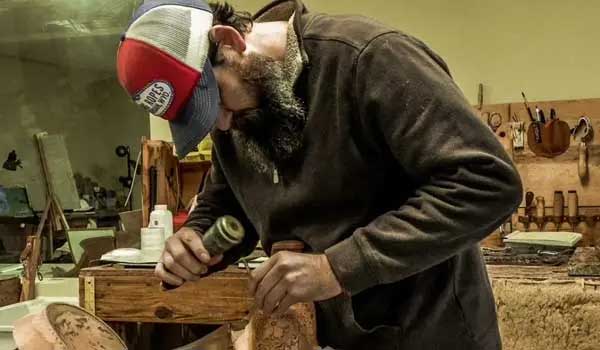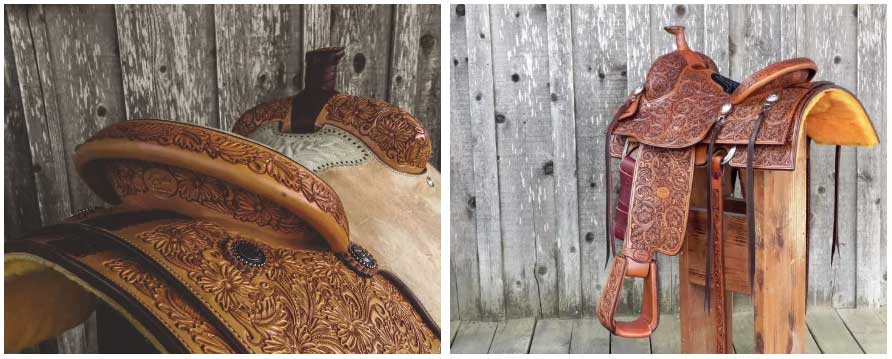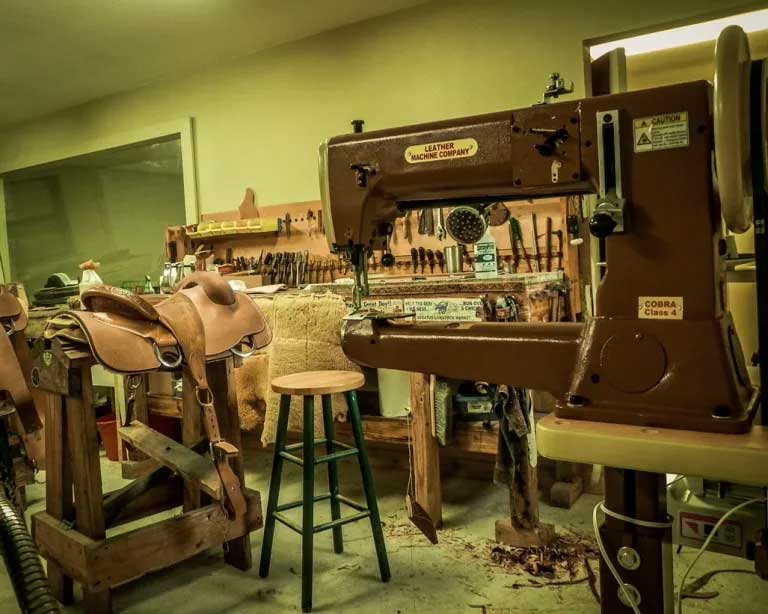
By Nick Pernokas
Many of us, who have been in the leather business for a long time, started out with Al Stohlman books and Tandy Leather tools. Some craftsmen were even able to go to a Tandy store and take lessons. For the young person interested in the leather business now, it’s a brave new world; one unlimited by the brick-and-mortar walls of the nearest leather dealer.
Since ShopTalk! last spoke with saddlemaker Don Gonzales for the April 2019 issue, he has moved into a new shop in Moulton, Texas. The historic building was, by chance, home to a boot and shoe shop owned by Rudy Simper many years ago. With 2700 square feet, the property has room for a retail area, a shop, and just as important, room to record digital media. Although Don continues to custom make high-end saddles and gear, his foray into the digital world of social media is an important example to all of us in the leather industry.
Aided only by his wife Claudia now, Don splits his time between building leather products and teaching about the process. In addition, he has a podcast which seeks to preserve the stories of other craftsmen and the history they embody.
Around 2010, one of Don’s employees encouraged him to start posting on Facebook. His pictures of products under construction were a hit, and he developed a following of both potential customers and other leather craftsmen. After a while, his personal shop page had surpassed 5,000 “Friends,” which was the most allowed; so, he converted it into a business page, which has an unlimited ceiling.
After that, Don moved on to Instagram. He enjoyed it more than Facebook because so many artists and craftsmen were posting pictures of their work on it. Don uses it as a posting page because Instagram is primarily a platform for images. He doesn’t consider himself a marketing expert on social media, but he knows what works for him.
“I try to post two or three times a day on Instagram. Just a cool picture, “says Don. “It doesn’t always have to be a finished product that I’m trying to sell. Just an interesting picture.”
Don really likes to post “in process” pictures, like an unfinished piece on the tooling bench. This helps to educate people that think one big machine stamps out the leather carving.
“I like to pull that curtain back and show how things are getting made.”
Don thinks that social media is constantly changing, driven by changing algorithms. Even if you take a course in it, the platform will be evolving away from your knowledge. When Instagram “Stories” came out, Don didn’t use it at first and stuck with static pictures. When he did begin to utilize it, he found that he increased his viewership because people liked the 15-second video clips. He could use a screenshot of his latest YouTube video and then post a link so that viewers could go directly to the full-length video.
“We’ve been using Stories for two or three years now, and people seem to enjoy them.”
When Instagram added “Reels” to its repertoire, Don started using them for short how-to videos. Although they’re not as in depth as a YouTube video, they do encourage people to go to Don’s YouTube page to see the whole process. Reels can really increase your following if you use it right.
Don thinks that subscriber numbers can be misleading. He has 60,000 subscribers on YouTube, but he considers that a “vanity” number. The important number is the number of people that are actually watching your videos.
“Everything we do on Facebook, Instagram and YouTube, points right back to DGSaddlery.com because we own that page. We don’t own those social media platforms. The goal is to turn eyeballs into email addresses. At that point, they’re your customer.”
This is the point where the viewer buys a ball cap, pattern or a leather product, and this is what Don considers a quality conversion. The most important thing about using social media is having a property on the web that you own.
“You can then utilize all these social media platforms to direct these people back to your house. They’re now in your shop and in your community.”
Don had created a YouTube channel several years before he actually started posting teaching videos on it. He had taught a few college kids that had come to the shop to work part time. He enjoyed doing it, but he had to teach them rapidly because they were on the payroll.
Around 2014, Don posted a low production value video that he shot with his cell phone. People were hungry for tips on leatherwork and the response was good. Don improved the quality of the next videos, and the number of subscribers went up. The teaching was fun, but film production took him away from his shop work. The next question was how to monetize these free videos. Don began to create virtual patterns to go along with his videos. They ranged from belt work to larger floral tooling patterns. The patterns were transferred through a PDF file and only cost the customer $5. Recently, he added the monetization feature of YouTube, which allows a producer to make money if YouTube runs ads on their videos.

“It started growing and we tried to see how far we could go with it.”
Don continued to add new subjects to his library, but the trick was to balance it with the backlog of products that he actually had to build. He tries to turn new videos out on a consistent schedule, but some weeks he has to stay at the bench. Two years ago, he created the “Monday Morning Briefings.” This is an informal, video visit over a cup of coffee with his viewers so he can stay in touch with them. It allows him to share what he’s doing in the shop and what new products will be coming out on the leathercraft side of the business. Today, Don uses a GoPro Hero 5 and an iPhone 11 to shoot his video content.
An online tooling class is his latest project. The students receive a virtual pattern pack and follow along with instruction over their phones or computer. As they finish each project, they can get it critiqued by Don. He admits that it’s probably not as effective as being shoulder to shoulder with someone in a shop, but for cost effectiveness and availability of knowledge it’s the next best thing.
Although Don’s YouTube channel is completely educational, he’s found that a lot of orders for his leatherwork come from people who have watched the videos.
Don has long been a fan of listening to audio books and podcasts while he works. He liked listening to niche podcasts on popular subjects and how to do things like woodworking and blacksmithing. He realized that there weren’t any podcasts available on the leather, silver or related trades. Don thought that a podcast on the western trades would be a really good idea and filed it away.
One day, a video producer friend of his approached him. The producer had a customer who wanted him to produce a podcast for him. The producer had never done one before, so he asked Don if he’d like to be his “guinea pig.” The producer would produce a podcast for Don and use it to perfect his technique. Now, almost two years, 100,000 downloads and 30 episodes later, Lost Trade has become a staple for many craftsmen to listen to in their shops.
“We just reach out to folks that I’d be interested in talking to.”
These folks are people that we’d all like to speak with, craftsmen like Chuck Stormes and Bruce Cheaney.
Don lets his guests talk about their craft for as long as they’d like to. Don and his producer do most of the work. An editor who works for the producer has taken over editing the podcasts. Zoom is the medium that Don conducts his interviews on and he does it through his computer. Zoom saves a separate audio file for each person on the call, so it makes editing easy.
“I’m not a podcast professional, so the production values are low, but the information is high quality.”
The podcast is currently what Don calls a “passion project.” In other words, it’s not monetized for any of the participants. This allows Don to have more freedom with his schedule and content.
“With our orders that we have on our bench to build and also the growth that’s coming on the teaching side of the business, it’s trying to balance everything out.”

Don feels that social media has helped create a leather renaissance because makers and, maybe more importantly, customers are being exposed to more types of leather art. It has created a freedom for the craftsman to expand beyond the way “it’s always been done” in his area.
If you would like to see how Don’s riding the wave of internet information, you can find most of it by going to DGSaddlery.com. There are links there for his work, as well as his teaching. Lost Trade with Don Gonzales can also be easily accessed from there or search “Don Gonzales” on YouTube to view his YouTube videos.
Don Gonzales Saddlery
110 S. Main St, Moulton, TX 77975
(979) 775-6300
This article originally appeared on Shop Talk Magazine and is published here with permission.
There are more interesting articles in our section on Tack & Farm.
































